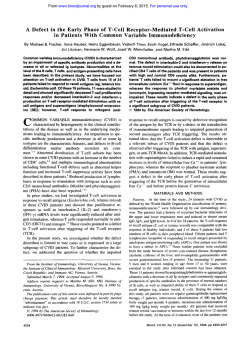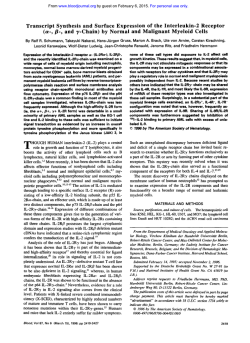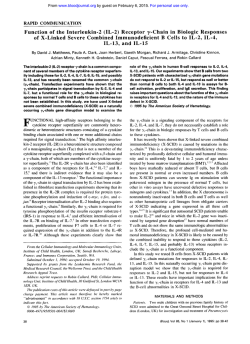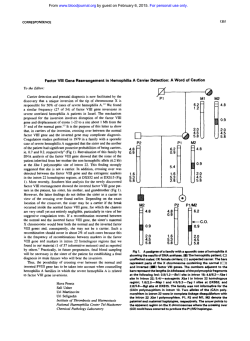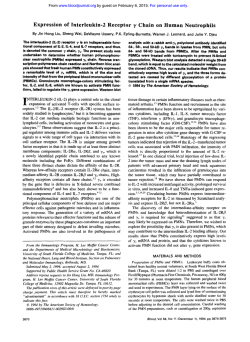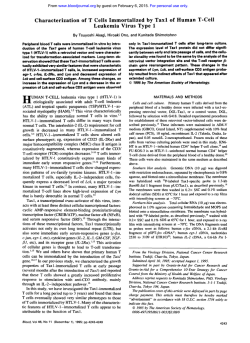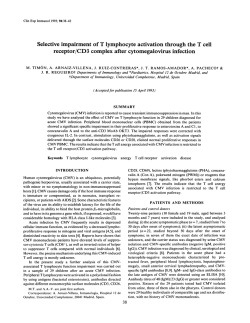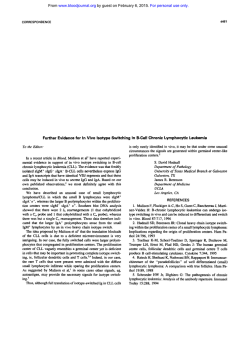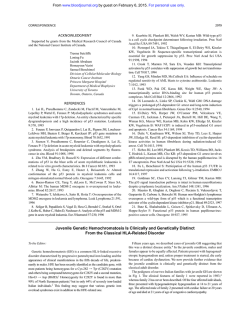
Interleukin-2-Transduced Lymphocytes Grow in an Autocrine
From www.bloodjournal.org by guest on February 6, 2015. For personal use only.
Interleukin-2-Transduced Lymphocytes Grow in an Autocrine Fashion and
Remain Responsive to Antigen
By Jonathan Treisman, Patrick Hwu, Seijiro Minamoto, Gwen E. Shafer, Robert Cowherd, Richard A. Morgan,
and Steven A. Rosenberg
The maintenance of T lymphocytes in vivo after adoptive
transfer for immunotherapy requiresthe systemic administration of interleukin-2 (IL-2). but prolonged administration
of IL-2 is associated with substantial toxicity. The constitutive production of IL-2byTcellsmaybeanalternative
method to prolong T-cell survival and potentially augment
antitumor responses. To study the effects of constitutive
production of IL-2 on the growth and antigen reactivityof a
murine T cell, the sperm-whale myoglobin ( S W ) specific
T-cell line 14.1 was retrovirally transduced with the cDNA
for IL-2.Cells that were transducedwith vectors without an
internal promoterwere able to proliferate inthe absence of
exogenously added IL-2, and
to grow in an autocrine fashion.
These vectors used an internal ribosomal entry site (IRES)
I
NTERLEUKIN-2 (IL-2) is a central mediator of the
growth and function of T
Studies have
shown that the systemic administration IL-2 may result in
antitumor responses both in murine tumor models as well
as in patients with ~ a n c e r .Furthermore,
~.~
IL-2 has been used
to stimulate the ex vivo proliferation and growth of immune
effector cells, including tumor-infiltrating lymphocytes
(TIL), which have specific lytic activity against autologous
The concomitant administration of IL-2 is required
for the efficacy of adoptively transferred TIL, most likely
because the ex vivo generation of effectors uses high concentrations of IL-2 and results in a dependency of the cells for
exogenous IL-2. Indeed, studies using TIL that have been
marked by retroviral transduction with the neomycin phosphoribosyl transferase gene (neo’) have shown that the cells
are often no longer detectable shortly after the discontinuation of systemic L - 2 treatment.’ The high levels of IL-2
required for therapy are associated with significant toxicity,
including hypotension, which limits the duration of E - 2
adrnini~tration.4,~
Insertion of the L - 2 gene into the effector
cells may allow for continued growth of the T cells in the
absence of exogenous IL-2.9.”
Despite the ability of IL-2 to function as a T-cell growth
factor, IL-2 also functions as an immunoregulatory factor in
T cells and can limit responsiveness of T cells to antigen.”
Interaction of lymphocytes that are proliferating in response
to L - 2 with antigen may result in apoptosis of the cells.’*
Thus, the autocrine production of L - 2 by Tcells could result
in functional defects. To study the effects of the constitutive
production of IL-2 by T cells could result in functional defects. To study the effects of the constitutive production of
IL-2 by T cells on their growth and antigen reactivity, the
sperm-whale myoglobin (SWM) specific murine T-cell line
14.113 was retrovirally transduced with the cDNA for IL-2.
After G418 selection, cells grew continuously in an autocrine
fashion in the absence of exogenous IL-2. The transduced
cells retained specific antigen reactivity. These results confirm previous report^^^'^ that the constitutive production of
IL-2 may allow the prolonged growth of T cells in the absence of IL-2 supplementation and extend these studies by
showing that T-cell antigen reactivity is maintained in these
cells.
Blood, Vol 85, No 1 (Januaw l), 1995:
pp 139-145
to allow translation of the neomycinphosphotransferase
(neo‘) gene. In contrast, the cells transduced with an11-2
vector in whichthe neo‘ gene was under the transcriptional
to proliferateor
control of an internal SW40 promoter failed
The prolifergrow in the absence of exogenously added 11-2.
ation of the cells growing without IL-2 could be inhibited
with antibodies to the 11-2 receptor or to human IL-2, indicating that they were still IL-2 dependent. Despite their autocrine growth, no tumor formation was observed in syngeneic miceinjectedsubcutaneouslywith the transduced cells,
and the cells retained their antigen reactivity and specificity.
These results suggest that autocrine growth of T cells for
therapy will not interfere with effector function.
0 1995 by The American Society of Hemsto/ogy.
MATERIALS AND METHODS
Cell lines. The murine T-cell line 14.1, a clonal C M + lymphocyte specific for SWM (kindly provided by Dr J. Berzofsky, National
Cancer Institute, Bethesda, MD),” was maintained in 1:l mixture
of RPMI/EHAA containing 10% fetal calf serum (FCS), glutamine
(2 mmoVL), penicillin (100 U/mL), streptomycin (100 @ml;
Biofluids, Inc. Rockville, MD) and recombinant IL-2 (300 IU/mL;
Cetus Division of Chiron, Emeryville, CA). Cells were split every
3 to 5 days and maintained at 0.5 X lo6 celldml.
Retroviral vectors. The cDNA for IL-2 was derived from the
PE-2 50A vector by enzymatic digestion using Pst I and Stu I, and
was treated with Klenow fragment of DNA polymerase I to blunt
the ends. The fragment was then inserted into the Hpa I site of the
LXSN retroviral vectorI4to form the LIL-2SN vector. The GIL-2EN
vector was derived by insertion of the blunt-ended XhoI-EcoRI
fragment from LIL-2SN into the SnaBI site of the pGlEN vector.”
The SAM-IL-ZEN vector was derived by polymerase chain reaction
(PCR) amplification of wild-type Moloney murine leukemia virus
(MMLV) using oligonucleotides flanking the splice acceptor site
(SA) of the env region. The sequence of the oligonucleotide primers
are: 5‘-CTC GAC CCG GCC GTG ACA AGA-3’. complementary
to pol nucleotides (nts) 5444 to 5464 but containing base substitutions to remove a potential ATG start codon and produce an Eag I
site, and 5’-TAG ACT GAC GCG GCC GCT TCA ACG CTC-3’,
complementary to env nts 5768-5794 with base substitutions to destroy the env start codon and produce an Not I restriction site. The
PCR product was digested with Eag I and Not I and ligated into the
Not I site of the pGlEN retroviral vector. Finally, the Not I-Xho I
fragment of GIL-ZEN containing the IL-2 cDNA was inserted into
the Not I-Xho I sites of the pSAM-EN vector.
Recombinant retroviral packaging lines. The ecotropic retrovi-
Fromthe Surgery Branch, National Cancer Institute, National
Institutes of Health, Bethesda, MD.
Submitted June 13, 1994; accepted September 7, 1994.
Address reprint requests toJonathan Treisman, MD, Surgery
Branch, National Cancer Institute, National Institutes of Health.
Bldg 10, Room 2B42, 9OOO Rockville Pike, Berhesda, MD 20892.
The publication costs of this article were defrayed in part by page
charge payment. This article must therefore be hereby marked
“advertisement” in accordance with 18 U.S.C. section 1734 solely to
indicate rhis fact.
0 1995 by The American Society of Hemarology.
00”4971/95/8501-0010$3.00/0
139
From www.bloodjournal.org by guest on February 6, 2015. For personal use only.
TREISMAN ET AL
140
ral packaging cell line GP + E86I6 (kindly provided by Dr A. Bank,
Columbia University, New York, NY), and the amphotropic retroviral packaging cell line PA317" (American Type Culture Collection
[ATCC], Rockville, MD) were maintained in Dulbecco's modified
Eagle's medium (DMEM) supplemented with 10% FCS, glutamine
(2 mmoVL), penicillin (100 UlmL), and streptomycin ( 1 0 0 pglmL)
(all from Biofluids, Inc, Rockville, MD). Retroviral producer lines
were made by introduction of the IL-2 vectors by calcium phosphate
transfection of a mixture of PA317 (2 X 10' cells) and GP + E86
cells (3 X IO5) in 100-mm dishes. High-titer G418-resistant clones
were then selected.
Transduction oflyrnphocyres. The 14.1 cells were transduced by
culture of the cells in fresh packaging cell supernatant containing
polybrene (8 pglmL; Aldrich, Milwaukee, WI). Supernatant was
always filtered through a 0.22-pm cellulose acetate filter (Coming,
Coming, NY) before use to eliminate cellular contaminants. After
16 hours, the cells were incubated an additional 8 hours in fresh
supernatant, then were pelleted and resuspended in fresh medium.
After 24 hours, the cells were selected by culture in medium containing G418 (0.8 to 1 mg/mL; Life Technologies, Rockville, MD)
for 7 to 10 days.
Proliferation assay. T cells were washed and resuspended in
fresh medium and cultured at 1 X lo" cellslwell in 96-well flatbottom plates. For inhibition studies, cells were cultured in medium
alone or with either an antimurine IL-2 receptor a (mlL-2Ra) antibody (3C7.250 pglmL)," a neutralizing antibody against human IL2 (R&DSystems, Minneapolis, MN), or an antihuman IL-4 antibody
(1 1BI 1, 250 pg/mL).'9 After 24 hours 2 pCi of 'H-thymidine was
added to each well, and after an additional 4-hour culture, the cells
were harvested onto fiber paper using an automated cell harvester
(Wallac, Uppsula, Sweden), and radioactive uptake measured using
a scintillation counter (Wallac).
IL-2 assay. The 14.1 cells were washed thoroughly with phosphate-buffered saline (PBS) before culture. Cells (1 X IO6) were
incubated in fresh medium, or medium containing either an antimurine IL-2 receptor antibody (3C7.250 pg/mL)" or a control antibody
(1 1B11, 250 pglmL)." After 72 hours, the supernatants were aspirated, centrifuged at 2,000 rpm, decanted, and frozen at-20°C.
Frozen aliquots were analyzed using a human IL-2 enzyme-linked
immunosorbent assay (ELISA; R & D Systems, Minneapolis, MN)
and the values determined by comparing samples toknown standards
provided with the assay.
Norrhern hybridization. Total cellular RNA was extracted by
the guanidine-isothiocyanatetechnique and run in 20-pg aliquots on
a 1% denaturing agarose gel containing 2.2 molL formaldehyde.
RNA was transferred to nylon membranes (Duralon UV; Stratagene,
La Jolla, CA) using positive pressure, UV-cross linked, and hybridized at 68°C in QuikHyb (Stratagene) according to the manufacturer's protocols. Full-length cDNA template used as a probe for neo'
was radiolabeled with "P-labeled dCTP by random primer extension
to a high specific activity ( > l X IO9 d p d p g ) . After hybridization,
membranes were washed and filters were imaged by autoradiography
using Kodak XAR film (Eastman Kodak, Rochester, NY).
Lymphocyte stimulation and interferon-y (IFN-y ) assay. After
washing with PBS, 2.5 X l @ 14.1 cells were cocultured with 2.5
X IO6 BALBlc splenocytes in the presence or absence of SWM (4
pmolL) or ovalbumin (71 pg/mL) (both from Sigma Chemical CO,
St Louis, MO). The 14.1 cells were also stimulated with anti-CD3
(2Cll; Pharmingen. San Diego, CA) which was precoated for 16
hours onto wells of a 24-well plate using a 4-pglmL solution in
bicarbonate buffer. After 24 hours, the supernatants were aspirated,
centrifuged at 2,000 RPM to remove cells and debris, decanted, and
stored at -20°C. Thawed aliquots were tested inan ELBA for
murine IFN-y (Endogen, Inc. Boston, MA) and values determined
1 x108
4 x 10%
B
4.0 kb-
1.6kb-
0
' t1
Fig 1. (A) Schematic representation of the IL-2 gene within the
retrovirel vectors LXSN, pG1EN. and pSAM-EN. The 3' terminus of
the polregion which contains the splice acceptor(SA) was
PCR amplified from wild-type MMLV witha 5' Eag I site and a 3' Not I site, and
inserted into theNot I site of the pGlENvector, recreating a unique
Not I site in thepolylinker. In all three vectors, the 11-2 gene is under
the transcriptional control of the MMLVLTR. The neo' gene is either
under the transcriptional control of the SV-40 early region promoter,
or is translated from the LTR-directed transcript from the IRES. (B)
Northern blot analysis oftotal cellular RNA from 14.1 cellstransduced
with the IL-2 vectors probed with neo' gene. The "Ckb band in the
transduced cells corresponds to the LTR-driven transcript. A slightly
smaller band in the 14.1 SAM-IL-ZEN RNA corresponds with the expected size of the spliced transcript. A 1.6-kb transcript is also seen
in the LIL-ZSN corresponding to the SV-40-driven transcript.
by comparing the samples with known standards included in the
assay.
Animal studies. Female BALBlc mice were approximately 8
weeks old at the time of use. The 14. I cells were washed three times
in PBS, resuspended in Hank's Balanced Salt Solution (HBSS), and
inoculated subcutaneously in a 0.2-mL volume on the abdomen using
a 26-gauge needle.
RESULTS
Retroviral construction. Retroviral-based vectors were
used because they offer the advantage of high-efficiency
gene transfer and stable integration of the gene. In all three
of the retroviral constructs, the cDNA coding for IL-2 was
under the transcriptional control of the MMLV long-terminal
repeat (LTR). In all three retroviral vectors, the 3' AU-rich
untranslated region of the IL-2 cDNA was deleted, because
it is known to be associated with decreased mRNA stability." As shown in Fig 1, one of these constructs is based on
From www.bloodjournal.org by guest on February 6, 2015. For personal use only.
GROWTH AND FUNCTION OF IL-2-TRANSDUCEDT-CELLS
the LXSN vectorI4 in which the neomycin phosphotransferase (neo? gene is under the transcriptional control of the
SV-40 early region promoter. The other two vectors, pGIL2EN and pSA"IL-2EN, contain an internal ribosomal entry
site (IRES) from the encephalomyocarditis virus 5' to the
neo' gene, and do not contain an internal prom~ter.'~.''These
vectors produce a single RNA transcript from which either
the L - 2 or neo' may be translated.
The wild-type retroviral RNA is spliced to allow for the
expression of the envelope gene message, with the splice
acceptor site present in the pol region of the virus. The pol
region has been removed in the retroviral vectors, and thus
the splice acceptor site is not present in either the LXSN
and pGlEN vectors. To try to maximize translation, the
splice acceptor site (SA) was reinserted into the IRES vector
by PCR amplification of the SA and the flanking regions of
MMLV and insertion 5' to the cloning site of the pGlEN
vector. The maximal titer obtained for the producer lines of
the IRES-containing vectors was approximately 5- to20fold higher than that of the LXSN-based vector producer
lines (Fig 1A).
Retroviral RNA expression in the 14.1 cell line which
were transduced with the IL-2 vectors and selected in G418
was studied by Northern blot analysis of total cellular RNA
using neo' cDNA as a probe. As shown in Fig lB, an MMLV
LTR-driven transcript was present in all three of the transduced cells. The levels of message appeared to be somewhat
higher in cells transduced with the GIL-2EN and SAM-IL2EN vectors. There was abundant levels of SV-40-driven
transcript in the 14.1 transduced with LIL-2SN. A second
band, slightly smaller than the LTR-driven transcript, was
present in RNA from the 14.1 transduced with the SAM-IL2EN vector, and most likely represents the spliced form of
the LTR-driven transcript.
Proliferation of transduced lymphocytes. To determine
Cell line
Fig 2. Proliferation of the 14.1 transduced with the cDNA for IL2. After selection in G418 for 10 days, 14.1 cells were washed and
3 days (A) or 7 days (B) in medium alone or medium
cultured for either
by 'H-thymiwith 11-2 (150 IlJlmLI, and then assayed for proliferation
dine uptake.
141
the effect of transduction on the 14.1 cells, we firstexamined
the responsiveness of the cells to IL-2 by proliferation
assays. After transduction and selection of the lymphocytes
in G418 for 10 days, the cells were washed and cultured at
1 X lo5 cells/well in medium alone or medium with IL-2
(150 IU/mL) for 3 or 7 days, and the proliferation of the cells
was measured by 3H-thymidine incorporation. As shown in
Fig 2,the level of 3H-thymidineuptake by the nontransduced
14.1was minimal in the absence of exogenous IL-2. The
14.1 transduced with the L-IL-2SN construct also showed
minimal proliferation in the absence of IL-2. By contrast,
14.1 transduced with either the GIL-2EN or SAM-IL-2EN
proliferated in the absence of exogenously added IL-2. The
proliferation of the 14.1-SAM-IL-2EN appeared to be
greater than that of the 14.1 GIL-2EN. Similar proliferative
responses were observed in experiments with cells from
three separate transductions with these vectors.
Growth of IL-2-transducedcells.
The proliferation of
the transduced 14.1 in the absence of exogenously added IL2 suggested the potential for autocrine growth of these cells.
To determine the autocrine growth of the lymphocytes, cells
were washed with PBS and resuspended in fresh medium
without IL-2 and growth of the cultures was measured. As
shown in Fig 3A, both the GIL-2EN and SAM-IL-2ENtransduced 14.1 grew logarithmically in IL-2-free medium.
Similar growth was measured in an independent experiment.
The growth of the cells transduced with the SAM-IL-2EN
vector paralleled that of the nontransduced 14.1 grown in
medium with IL-2 (Fig 3B). No growth was observed by
either the nontransduced cells or the LIL-2SN transduced
cells when cultured in IL-2-free medium.
Inhibition of proliferation by antibodies to human IL-2
and the murine IL-2 receptor. To determine if the increased
proliferation was actually a function of human IL-2 production, transduced cells that had been in continuous culture in
medium without exogenous IL-2 for over 120 days were
washed and cultured for 24 hours alone or in the presence
of an antibody to human IL-2 (R&D Systems) or an antibody
to the murine IL-2 receptor a chain (mIL-2R) (3C7). As
shown in Fig 4, proliferation of the SAM-IL-2EN-transduced cells was inhibited byboth the anti-IL-2 receptor
antibody as well as the antibody for human IL-2, but not by
a control antibody, 11B11, which recognizes murine IL-4.I9
An additional experiment showed similar inhibition. Proliferation of the GIL-2EN-transduced cells was similarly inhibited by these antibodies (data not shown).
IL-2 production by transduced 14.1. The proliferative
response of the 14.1 suggested that the cells were constitutively producing IL-2. Because the human IL-2 ELISA does
not cross-react with murine IL-2, the production of human
IL-2 from the transgene can bespecifically measured in
the murine cell line 14.1. To determine the levels of IL-2
production, cells transduced with either the GIL-2-EN or
SAM-IL-2EN vectors that had been cultured in recombinant
human IL-2 free medium for over 60 days were assayed for
human IL-2 by ELISA. The levels of human IL-2in the
supernatants after 72-hour incubation were detectable, although low (Table l). Increased amounts of IL-2 were detected in the presence of the antimurine IL-2 receptor anti-
From www.bloodjournal.org by guest on February 6, 2015. For personal use only.
142
TREISMAN ET AL
1012
1011
-S
lo
X
v
L
2
-A
1010 108
14.1 LIL-2SN
14.1 GIL-2EN
-P- 14.1 SAIL-PEN
-
107 -
6o
106 -
5
105
=
104 -
8
103
C
-
109 - "3- 14.1 NV
1
T
T
-
I
102
10'
100
0
7 14 2128
35 4249
56 6370 77 84 9198
Day of culture
20
107
B
106
-0" 14.1 NV
h
W
S
-z
104
5
103
3
102
X
14.1 NV + IL-2
14.1 SAIL-PEN
t 14.1 SAIL-PEN+ IL-2
105
-19%
-A-
n
I
I
anti-mlL-2R
anti-hlL-4
anti-hlL-2b
n
C
101
100
0
7
14
21
20
35
42
I
Fig 4. Inhibition of 14.1 cell proliferation by antibodies to human
IL-2 andmlL-2 receptor. After prolonged (>l20 days) culture in medium containing no exogenous IL-2, the 14.1 cells transduced with
the SAM-IL-PEN vector were washed and cultured without IL-2 for
24 houm in medium alone, medium plus rat-antimurine IL-2 receptor
antibody 3C7 (250 pg/mL), or the rat-antimurine IL-4 antibody l l B l l
(250 pg/mL) as a control. Cells were alsocultured with goat-antihuman IL-2 ("5pg/mL or b50pg/mL) (R&D Systemsl.
Day of culture
Fig 3. Growth of 14.1 transduced with the cDNA for 11-2. (A) The
14.1 cells were washed and cultured in medium without IL-2 and
viable cell number measured by cell counting with trypan blue. Cell
number was calculated bymultiplying the fold expansion x original
cell number. (B) Comparisongrowth
of
of the SAM IL-ZEN transduced
and nontransduced 14.1 cells in medium alone or medium supplemented with IL-2 (150 IUlmL).
body, 3C7," but not in the presence of a control antibody
11B 11 that recognizes IL-4I9 (both 3C7 and 11B11 were a
kind gift from Dr M.J. Lenardo, National Institute of Allergy
and Infection Disease).
Antigen response of IL-2-transducedcells.
To determine the antigen responsiveness of 14.1 transduced with IL2 cDNA, the cells grown for 90 days in the absence of
IL-2 were stimulated with SWM presented on syngeneic
splenocytes. As shown in Table 2, the transduced cells responded to the SWM as measured by the production of IFNy and this response was specific for the antigen, because
I m - y was not produced in response to splenocytes alone
or splenocytes with ovalbumin.
Lack of growth of transduced cells in mice. Previous
studies have suggested that an autocrine loop may result in
the tumorigenicity of lymphocytes.'~'"~2z
To determine if the
14.1 growing in an autocrine fashion were similarly tumorigenic, cells (1 to 2.5 X 10'/mouse) were injected subcutaneously in the abdomen of syngeneic BALB/c mice. Tumor
formation was not observed, even after prolonged observation (90 days), in either of two experiments with a total of
seven mice in each group (data not shown).
Table 1. IL-2 Production by IL-2-Transduced 14.1
IL-2 Concentration ipg/mL)t
Cell Line
None
Medium +
Anti-IL-ZR*
None
14.1
14.1-GIL-ZEN
14.1-SAM-IL-ZEN
3.4
0
8.3
68.0
0
0
125.8
403.1
Anti-IL-4t
0
0
8.3
64.3
Anti-IL-2R antibody 3C5 was used a t a concentration of 250 pg/
mL.
t Antimurine IL-4 antibody 11B11 was used at a concentration of
250 wg/mL.
14.1 were washed and cultured for 72 hours and the supernatants
harvested. IL-2 concentration was measured by human IL-2 E L S A
(R&D Systems).
*
From www.bloodjournal.org by guest on February 6, 2015. For personal use only.
GROWTH
143
AND FUNCTION
T-CELLS
OF IL-2-TRANSDUCED
Table 2. Antigen Response of IL-2-Transduced 14.1
Stimulator Splenocytes +
No
Stimulation
None
Cell Line
None
14.1
14.1-LIL-2SN
14.1-GIL-2EN
14.1-SAM-IL-ZEN
SWM
Ovalbumin
2Cll
67
137
272
126
160
0
94,652
32.481
32,127
> 100,000
IFN--y (pglmL per 10' cellsL24 h )
107
261
0
39
0
202
183
378
2 50
47
DISCUSSION
Adoptive cellular immunotherapy has been shown to produce sustained remissions of metastatic tumors in some cancer patients7 Such cells generally have been grown ex vivo
in high concentrations of recombinant human IL-2 and require an exogenous source of IL-2 to maintain their viabilit^.^ Because the administration of systemic IL-2 is associated with substantial toxicity, alternative methods are being
sought that can be used to maintain the growth of the cells
after transfer to the patient. The production of IL-2 by a T
cell may result in an autocrine loop, allowing continued
growth of the cell. In the present studies we have shown
that the introduction of the human XL-2 cDNA into murine
T lymphocytes resulted in their sustained growth in the absence of exogenous IL-2. This was manifested both by proliferation after withdrawal of IL-2, as well as prolonged growth
in the absence of exogenously added IL-2. In addition, these
studies suggest that the production of IL-2 and autocrine
growth does not impair the antigen reactivity of the cells.
The production of IL-2 by T cells is limited by the tightly
controlled transcription of the IL-2 gene and the instability
of its mRNA.20,23
In the vectors used in this study, the IL-2
gene was under the transcriptional control of the MMLV
LTR, which should result in constitutive expression of the
gene product. The 3' untranslated region of the gene was also
deleted, because its presence is known to result in mRNA
instability. The vectors used were also bicistronic, allowing
the expression of both the IL-2 gene as well as the dominant
selectable marker, neo'. In these studies there was a large
difference in growth properties observed between the 14.1
cells transduced with the LIL-2SN vectors and the two IREScontaining vectors. The LIL-2SN construct contains an internal SV-40 promoter, which drives the transcription of the
neor gene. By contrast, the two IRES vectors have only a
single promoter, the MMLV LTR. The vectors code for a
single transcript which contains an IRES to facilitate translation of the neo'. The adequate expression of neor is necessary
because the efficiency of transduction of lymphocytes is
Because all of the constructs use the MMLV LTR to
drive transcription of the IL-2 gene, the differences between
the growth of the selected cells implies that the SV-40 promoter may adversely affect LTR-driven transcription.
In the wild-type MMLV virus, the env region is transcribed by splicing of the gag and pol regions, with the splice
acceptor present in the 3' region of the pol region of the
virus. In the MMLV-based retroviral vectors, including the
61 4
32,352
32,030
37,070
>100,000
LXSN series of vectors, the env, pol and the majority of gag
regions of the virus are deleted. Because the splice acceptor
is in the pol sequence, it is also deleted in these vectors.
This leaves multiple ATG sites 5' to the start site of the
gene of interest, which could potentially act as translation
start sites and interfere with gene expression. Although splicing can occur due to cryptic splice acceptor sites within the
vector,I4 it may also interfere with gene expression by splicing within the gene sequence. The insertion of a splice acceptor 5' to the expressed gene, analogous to that present 5'
to the env gene of the wild-type vector, might result in
controlled splicing of the transcript. The pSAM-EN vector
was made by placing the env gene splice acceptor and the
adjacent sequence into the IRES-containing vector pG1EN.
The pSAM-EN is similar to the MFG vector used by Dranoff
et al,25 but the MFG vector does not contain a selectable
marker. Another difference between the SAM-EN vector and
the MFG vector is the elimination of the env start codon.
This modification permits the use of the native start codon
of the inserted gene, and greatly increases the utility of the
SAM-EN vector. In addition, the lack of the MMLV env
gene start codon decreases the potential that recombination
between the vector and the packaging genome will generate
replication competent helper virus.
The 14.1 transduced with the splice acceptor containing
vector SAM-IL-2EN showed greater proliferation in IL-2free medium than the cells transduced with a vector containing the IRES alone. The initial growth rate was also
higher in the SAM-IL-2EN-transduced cells but the eventual growth rate was similar to that of the 14.1 transduced
with GIL-2EN vector. This could be the effect of a higher
titer of the SAM-IL-2EN supernatant resulting in a higher
percentage of the cells transduced and thus fraction of expanding. However, even after G418 selection and 90 days
in IL-2-free medium, the cells transduced with the SAMIL-2EN vector produced larger amounts of IL-2 than did the
14.1 cells transduced with the GIL-2EN vector. Thus, the
presence of the splice acceptor may provide for increased
production of IL-2 by the transduced cells.
Despite the marked proliferation of the transduced lines
in the absence of supplemented IL-2, the detected levels of
secreted IL-2 were low. This was probably caused by the
rapid uptake of the secreted IL-2 by the lymphocytes. Additionally, some of the cells may not have produced IL-2, but
used IL-2 produced by other cells. To test if the proliferation
of the transduced cells was due to autocrine production of
From www.bloodjournal.org by guest on February 6, 2015. For personal use only.
144
IL-2, cells were cultured in the presence of an antibody to
the mIL-2R. The proliferation of the transduced cells was
inhibited. Similarly, antibody to human IL-2 also inhibited
the proliferation, further suggesting that the proliferation observed was caused by expression of the transgene. The lack
of complete inhibition may have been caused by insufficient
concentrations of blocking antibody. Alternatively, the secretion of IL-2 may result in greater interaction of the IL-2
with the IL-2 receptor. Incomplete blocking of proliferation
by antibody to the murine IL-2 receptor was also observed
in previous studies by Yamada et al.’’ Increased IL-2 production was also measured in the presence of a blocking antimurine IL-2 receptor antibody, further demonstrating the expression of the IL-2 gene.
Studies have suggested that persistent, constitutive production of IL-2 by T lymphocytes may lead to the autocrine
growth of these cell^^^'^ and this has been proposed as a
mechanism leading to leukemogenesis by T
This
was suggested by the finding that in vitro growth of a human
T-cell line isolated from a patient with non-Hodgkin’s Tcell lymphoma was related to autocrine stimulation by IL2.26 Also, the MLA 144 leukemia cell line constitutively
produces IL-2, and its growth can be inhibited by agents
that block IL-2 prod~ction.~’.~~
An autocrine loop has been
suggested for the growth of adult T-cell leukemidlymphoma
cells in which the IL-2 gene is transactivated by the human
T lymphotropic virus-I.22
In the current studies, the growth of the T cells transduced
with the SAM-IL-2EN and GIL-2EN vectors was ongoing
for over 100 days, suggesting that these lines are also immortalized. Still, the transduced cells did not differ in morphology from that of the parent line, nor did the transduced cells
form tumors when implanted subcutaneously in syngeneic
BALB/c mice, suggesting that the tumorogenicity of these
cells is low. Karasuyama et a19 also found no tumorigenicity
by the helper T-cell line HT-2 transfected with the cDNA
for IL-2, after subcutaneous or intraperitoneal injection of
the cells into syngeneic or irradiated mice. In their studies
tumor formation did occur in nude mice injected with the
transfected clones secreting the highest amounts of IL-2.
This may suggest a more complex interaction of IL-2 secreting T cells with other lymphocytes in situ, resulting in
growth inhibition. Yamada et all” have also demonstrated
that a murine cytotoxic T-cell line CTLL-2 infected with a
retroviral vector carrying the cDNA for the humanIL-2
resulted in proliferation in the absence of exogenous IL-2.
In contrast to our findings, tumor formation by the IL-2transduced CTLL line occurred even when injected into syngeneic mice.’” The potential for lymphogenesis, although
quite low, suggest that for clinical application itmay be
necessary to insert a suicide gene along with the gene for
IL-2 into T cells to be used for therapy.
The production of IL-2 by adoptively transferred T cells
might serve to both maintain the cells in vivo as well as to
enhance their ability to eliminate their target. Expression of
IL-2 may provide a means for breaking tolerance, similar to
that seen in a transgenic system.29The retrovirally mediated
expression of IL-2 by tumors can abrogate tumorigenicity
and result in immunologic recognition of the tumor.’”.”
TREISMAN ET AL
However, it has become increasingly evident that IL-2 may
serve a variety of immunoregulatory functions, and the exposure of cells to IL-2 may result in altered function. Cloned
helper T lymphocytes exposed to IL-2 may become unresponsive to antigen despite their ability to proliferate in response to IL-2.” Antigen stimulation of lymphocytes proliferating in response to IL-2 may also result in apoptosis of the
cells.” In the present study we observed that the lymphocytes
transduced with the IL-2 gene continued to recognize and
remain responsive to the SWM antigen, as measured by the
secretion of IFN-y. There also appeared tobenoloss
of
specificity for the antigen. Norwas there any increase in
the baseline production of IFN-y, suggesting that the cells,
although proliferating, werenot nonspecifically activated.
Thus, it appeared that the constitutive production of IL-2
and the ability togrowin the absence of exogenous IL-2
did not interfere with antigen recognition or cytokine release
by these transduced T cells.
Although this study shows the transduction and functional
expression of an IL-2 containing vector into a CD4’ T-cell
line, theability to transduce and express genes inCD8’
lymphocytes has been difficult. As previously reported,” the
insertion of vectors coding for the tumor necrosis factor-cy
gene into CD8’ TIL has resulted in relatively low levels of
expression compared with that of tumor lines. To date, the
transduction of both human and murine CD8+ TIL with
the IL-2 gene has resulted in little ifany measurable IL-2
production and has not led to their constitutive growth. A
variety of alternative approaches are currently being investigated that maynot require high levels of gene expression
and yet still potentially allow the growth of T cells without
the use of the high doses of IL-2 that are currently required.
The introduction into T cells of alternative cytokine receptors
or chimeric receptors that bind ligands other than IL-2, yet
signal through the IL-2 receptor, are currently being investigated. Still, the ability of IL-2-transduced T cells to grow
in an autocrine fashion yet maintain their antigenic reactivity
further suggests the potential utility of using lymphocytes
genetically modified to constitutively produce IL-2 for the
immunotherapy of tumors.
ACKNOWLEDGMENT
WethankPaul
assistance.
Spiess andLydiaChiangfor
excellent technical
REFERENCES
1. Morgan DA, Ruscetti W ,Gallo R: Selective in vitro growth
of T lymphocytes fromnormalhumanbonemarrows.
Science
193:1007,1976
2. Lotze MT: Interleukin-2: Basic principles, in DeVita VT, Hellman S, Rosenberg SA (eds): Biologic Therapy of Cancer. Philadelphia, PA, Lippincott, 1991, p 123
3. Waldmann TA: The structure, function and expression
of interleukin 2 receptors on normal and malignant lymphocytes. Science
232:727,1986
4. Rosenberg SA: Immunotherapyand gene therapy of cancer.
Cancer Res 51:5074s, 1991 (suppl)
5. Rosenberg SA, Lotze M, Yang J, Aebersold P, Linehan W,
Seipp C, White D: Experience with the use of high-dose interleukin2 in the treatment of 652 cancer patients. Ann Surg 210:474, 1989
From www.bloodjournal.org by guest on February 6, 2015. For personal use only.
GROWTH AND FUNCTION OF IL-2-TRANSDUCEDT-CELLS
6. Topalian S , Solomon D, Rosenberg SA: Tumor-specific cytolysis by lymphocytes infiltrating human melanomas. J Immunol
142:3714, 1989
7. Rosenberg SA, Packard BS, Aebersold PM, Solomon D, Topalian SL, Toy ST, Simon P, Lotze MT, Yang JC, Seipp CA, Simpson
C, Carter C, Bock S, Schwartzentruber D, Wei JP, White DE: Use
of tumor-infiltrating lymphocytes and interleukin-2 in the immunotherapy of patients with metastatic melanoma. N Engl J Med
319:1676, 1988
8. Rosenberg SA, Aebersold P, Cornetta K, Kasid A, Morgan R,
Moen R, Karson E, Lotze M, Yang J, Topalian S, Merino M, Culver
K, Miller AD, Blaese RM, Anderson WF: Gene transfer into humans-Immunotherapy of patients with advanced melanoma, using
tumor-infiltrating lymphocytes modified by retroviral gene transduction. N Engl J Med 323570, 1990
9. Karasuyama H, Tohyama N, Tada T Autocrine growth and
tumorigenicity of interleukin 2-dependent helper T cells transfected
with IL-2 gene. J Exp Med 169:13, 1989
10. Yamada G , Kitamura U, Sonoda H, Harada H, Taki S , Mulligan RC, Osawa H, Diamantstein T, Yokoyama S, Taniguchi T:
Retroviral expression of the human IL-2 gene in a murine T cell
line results in cell growth autonomy and tumorigenicity. EMBO J
6:2705, 1987
11. Otten G, Wilde DB, Prystowsky MB, Oshan JS, Rabin H,
Henderson LE, Fitch F W : Cloned helper T lymphocytes exposed to
interleukin 2 become unresponsive to antigen and concanavalin A
but not to calcium ionophore and phorbol ester. Eur J Immunol
16:217, 1986
12. Boehme SA, Lenardo MJ: Propriocidal apoptosis of mature
T lymphocytes occurs at S phase of the cell cycle. Eur J Immunol
23: 1552, 1993
13. Kurata A, Berzofsky JA: Analysis of peptide residues interacting with MHC molecule or T cell receptor. Can a peptide bind
in more than one wayto the same MHC molecule? J Immunol
144:4526, 1990
14. Miller AD, Rosman GJ: Improved retroviral vectors for gene
transfer and expression. Biotechniques 7:980, 1989
15. Morgan RA, Couture L, Elroy-Stein 0, Ragheb J, Moss B,
Anderson W Retroviral vectors containing putative internal ribosome entry sites: Development of a polycistronic gene transfer system and applications to human gene therapy. Nucleic Acids Res
20:1293, 1992
16. Markowitz D, Goff S , Bank A: A safe packaging line for
gene transfer: Separating viral genes on two different plasmids. J
Virol 62:1120, 1988
17. Miller AD, Buttimore C: Redesign of retrovirus packaging
cell lines to avoid recombination leading to helper virus production.
Mol Cell Biol 62895, 1986
18. Malek TR, Ortega RG, Jakway JP, Chan C, Shevach EM: The
murine L - 2 receptor. 11. Monoclonal anti-IL2 receptor antibodies as
145
specific inhibitors of T cell function in vitro. J Immunol 133:1976,
1984
19. Ohara J, Paul WE: Production of a monoclonal antibody to
and molecular characterization of B cell stimulatory factor-l. Nature
315:333, 1985
20. Shaw G , Kamen R: A conserved AU sequence from the 3’
untranslated region of GM-CSF mRNA mediates selective mRNA
degradation. Cell 46:659, 1986
21. Ghattas IR, Sanes JR, Majores JE: The encephalomyocarditis
virus internal ribosome entry site allows efficient coexpression of
two genes from a recombinant provirus in cultured cells and in
embryos. Mol Cell Biol 11:5848, 1991
22. Maruyama M, Shibuya H, Harada H, Hatakeyama M, Seiki
M, Fujita T, Inoue J, Yoshida M, Taniguchi T: Evidence for aberrant
activation of the interleukin-2 autocrine loop by HTLVl encoded
p4Ox and T3Ri complex triggering. Cell 48:343, 1987
23. Lindsten T, June CH, Ledbetter JA, Stella G, Thompson CB:
Regulation of lymphokine messenger RNA stability by a surface
mediated T cell activation pathway. Science 244:339, 1989
24. HwuP, Yannelli J, Kriegler M, Anderson WF, Perez C,
Chiang Y, Schwarz S , Cowherd R, Delgado C, Mu16 J, Rosenberg
SA: Functional and molecular characterization of tumor-infiltrating
lymphocytes transduced with tumor necrosis factor-a cDNA for the
gene therapy of cancer in humans. J Immunol 150:4104, 1993
25. Dranoff G, Jaffee E, Lazenby A, Golumbek P, Levitsky H,
Brose K, Jackson V, Hamada H, Pardoll D, Mulligan RC: Vaccination with irradiated tumor cells engineered to secrete murine granulocyte-macrophage colony-stimulating factor stimulates potent, specific, and long-lasting anti-tumor immunity. Science 903539, 1993
26. Duprez V, Lenoir G , Dautry-Varsat A: Autocrine growth
stimulation of a human T-cell lymphoma line by interleukin 2. Proc
Natl Acad Sci USA 82:6932, 1985
27. Rabin H, Hopkins W, Ruscetti F W , Neubauer RH, Brown
RL, Kawakami TG: Spontaneous release of a factor with properties
of T cell growth factor from a continuous line of primate tumor T
cells. J Immunol 127:1852, 1981
28. Smith KA: T-cell growth factor and glucocorticoids: Opposing regulatory hormones in neoplastic T cell growth. Immunobiology
161:157, 1982
29. Heath WR, Allison J, Hoffmann MW, Schonrich G , Hlmmerling G , Arnold B, Miller JF: Autoimmune diabetes as a consequence of locally produced interleukin-2. Nature 359547, 1992
30. Gansbacher B, Zier K, Daniels B, Cronin D, Bannerji R,
Gilboa E: Interleukin 2 gene transfer into tumor cells abrogates
tumorigenicity and induces protective immunity. J Exp Med
172:1217, 1990
31. Porgador A, Gansbacher B, Bannerji R, Tzehoval E, Gilboa
E, Feldman M, Eisenbach L: Anti-metastatic vaccination of tumorbearing mice with IL-2-gene-inserted tumor cells. Int J Cancer
53:471, 1993
From www.bloodjournal.org by guest on February 6, 2015. For personal use only.
1995 85: 139-145
Interleukin-2-transduced lymphocytes grow in an autocrine fashion
and remain responsive to antigen
J Treisman, P Hwu, S Minamoto, GE Shafer, R Cowherd, RA Morgan and SA Rosenberg
Updated information and services can be found at:
http://www.bloodjournal.org/content/85/1/139.full.html
Articles on similar topics can be found in the following Blood collections
Information about reproducing this article in parts or in its entirety may be found online at:
http://www.bloodjournal.org/site/misc/rights.xhtml#repub_requests
Information about ordering reprints may be found online at:
http://www.bloodjournal.org/site/misc/rights.xhtml#reprints
Information about subscriptions and ASH membership may be found online at:
http://www.bloodjournal.org/site/subscriptions/index.xhtml
Blood (print ISSN 0006-4971, online ISSN 1528-0020), is published weekly by the American
Society of Hematology, 2021 L St, NW, Suite 900, Washington DC 20036.
Copyright 2011 by The American Society of Hematology; all rights reserved.
© Copyright 2025
